Reading time: 16 min
There lived once an old Queen, whose husband had been dead many years. She had a beautiful daughter who was promised in marriage to a King’s son living a great way off. When the time appointed for the wedding drew near, and the old Queen had to send her daughter into the foreign land, she got together many costly things, furniture and cups and jewels and adornments, both of gold and silver, everything proper for the dowry of a royal Princess, for she loved her daughter dearly. She gave her also a waiting gentlewoman to attend her and to give her into the bridegroom’s hands; and they were each to have a horse for the journey, and the Princess’s horse was named Falada, and he could speak. When the time for parting came, the old Queen took her daughter to her chamber, and with a little knife she cut her own finger so that it bled; and she held beneath it a white napkin, and on it fell three drops of blood; and she gave it to her daughter, bidding her take care of it, for it would be needful to her on the way.
 Image: Otto Kubel (1868 – 1951)
Image: Otto Kubel (1868 – 1951)Then they took leave of each other; and the Princess put the napkin in her bosom, got on her horse, and set out to go to the bridegroom. After she had ridden an hour, she began to feel very thirsty, and she said to the waiting-woman, „Get down, and fill my cup that you are carrying with water from the brook. I have great desire to drink.“ – „Get down yourself,“ said the waiting-woman, „and if you are thirsty stoop down and drink. I will not be your slave.“ And as her thirst was so great, the Princess had to get down and to stoop and drink of the water of the brook, and could not have her gold cup to serve her. „Oh dear!“ said the poor Princess.
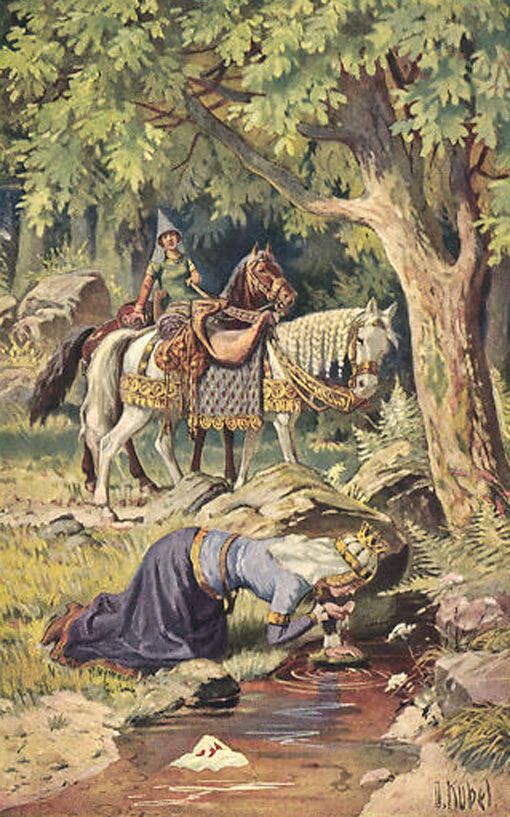 Image: Otto Kubel (1868 – 1951)
Image: Otto Kubel (1868 – 1951)And the three drops of blood heard her, and said, „If your mother knew of this, it would break her heart.“ But the Princess answered nothing, and quietly mounted her horse again. So they rode on some miles farther. The day was warm, the sun shone hot, and the Princess grew thirsty once more. And when they came to a water-course she called again to the waiting-woman and said, „Get down, and give me to drink out of my golden cup.“ For she had forgotten all that had gone before. But the waiting-woman spoke still more scornfully and said, „If you want a drink, you may get it yourself. I am not going to be your slave.“ So, as her thirst was so great, the Princess had to get off her horse and to stoop towards the running water to drink, and as she stooped, she wept and said, „Oh dear!“ And the three drops of blood heard her and answered, „If your mother knew of this, it would break her heart!“ And as she drank and stooped over, the napkin on which were the three drops of blood fell out of her bosom and floated down the stream, and in her distress she never noticed it. Not so the waiting-woman, who rejoiced because she should have power over the bride, who, now that she had lost the three drops of blood, had become weak, and unable to defend herself. And when she was going to mount her horse again the waiting-woman cried, „Falada belongs to me, and this jade to you.“ And the Princess had to give way and let it be as she said. Then the waiting-woman ordered the Princess with many hard words to take off her rich clothing and to put on her plain garments, and then she made her swear to say nothing of the matter when they came to the royal court; threatening to take her life if she refused. And all the while Falada noticed and remembered.
The waiting-woman then mounting Falada, and the Princess the sorry jade, they journeyed on till they reached the royal castle. There was great joy at their coming, and the King’s son hastened to meet them, and lifted the waiting woman from her horse, thinking she was his bride; and then he led her up the stairs, while the real Princess had to remain below. But the old King, who was looking out of the window, saw her standing in the yard, and noticed how delicate and gentle and beautiful she was, and then he went down and asked the seeming bride who it was that she had brought with her and that was now standing in the courtyard.
„Oh!“ answered the bride, „I only brought her with me for company; give the maid something to do, that she may not be for ever standing idle.“ But the old King had no work to give her; until he bethought him of a boy he had who took care of the geese, and that she might help him. And so the real Princess was sent to keep geese with the goose-boy, who was called Conrad.
Soon after the false bride said to the Prince, „Dearest husband, I pray thee do me a pleasure.“ – „With all my heart,“ answered he. „Then „said she, „send for the knacker, that he may carry off the horse I came here upon, and make away with him. He was very troublesome to me on the journey.“ For she was afraid that the horse might tell how she had behaved to the Princess. And when the order had been given that Falada should die, it came to the Princess’s ears, and she came to the knacker’s man secretly, and promised him a piece of gold if he would do her a service. There was in the town a great dark gate-way through which she had to pass morning and evening with her geese, and she asked the man to take Falada’s head and to nail it on the gate, that she might always see it as she passed by. And the man promised, and he took Falada’s head and nailed it fast in the dark gate-way.
Early next morning as she and Conrad drove their geese through the gate, she said as she went by:
„O Falada, dost thou hang there?“
And the head answered:
„Princess, dost thou so meanly fare? But if thy mother knew thy pain,
Her heart would surely break in twain.“
But she went on through the town, driving her geese to the field. And when they came into the meadows, she sat down and undid her hair, which was all of gold, and when Conrad saw how it glistened, he wanted to pull out a few hairs for himself.
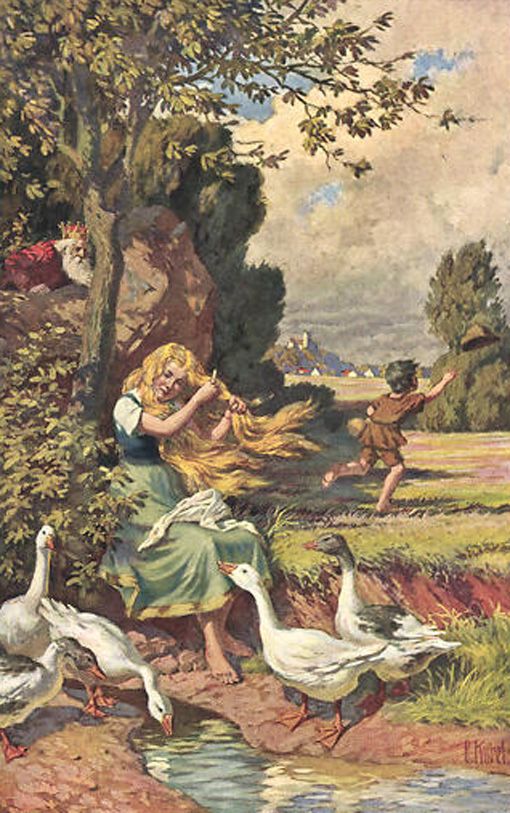 Image: Otto Kubel (1868 – 1951)
Image: Otto Kubel (1868 – 1951)And she said:
„O wind, blow Conrad’s hat away,
Make him run after as it flies,
While I with my gold hair will play,
And twist it up
in seemly wise.“
Then there came a wind strong enough to blow Conrad’s hat far away over the fields, and he had to run after it; and by the time he came back she had put up her hair with combs and pins, and he could not get at any to pull it out; and he was sulky and would not speak to her. So they looked after the geese until the evening came, and then they went home.
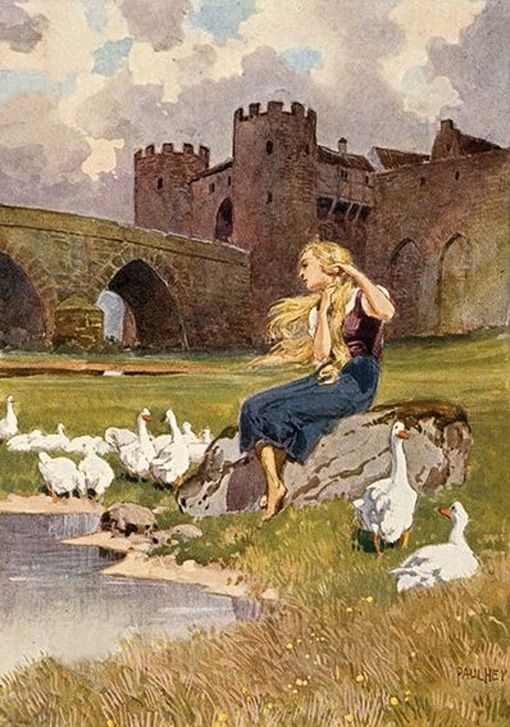 Image: Paul Hey (1867 – 1952)
Image: Paul Hey (1867 – 1952)The next morning, as they passed under the dark gate-way, the Princess said:
„O Falada, dost thou hang there?“
And Falada answered:
„Princess, dost thou so meanly fare? But if thy mother knew thy pain,
Her heart would surely break in twain.“
And when they reached the fields she sat down and began to comb out her hair. Then Conrad came up and wanted to seize upon some of it, and she cried:
„O wind, blow Conrad’s hat away,
Make him run after as it flies,
While I with my gold hair will play,
And do it up
in seemly wise.“
Then the wind came and blew Conrad’s hat very far away, so that he had to run after it, and when he came back again her hair was put up again, so that he could pull none of it out; and they tended the geese until the evening.
And after they had got home, Conrad went to the old King and said: „I will tend the geese no longer with that girl!“ – „Why not?“ asked the old King. „Because she vexes me the whole day long,“ answered Conrad. Then the old King ordered him to tell how it was. „Every morning,“ said Conrad, „as we pass under the dark gate-way with the geese, there is an old horse’s head hanging on the wall, and she says to it:
‚O Falada, dost thou hang there?‘
And the head answers:
‚Princess, dost thou so meanly fare? But if thy mother knew thy pain,
Her heart would surely break in twain.'“
And besides this, Conrad related all that happened in the fields, and how he was obliged to run after his hat.
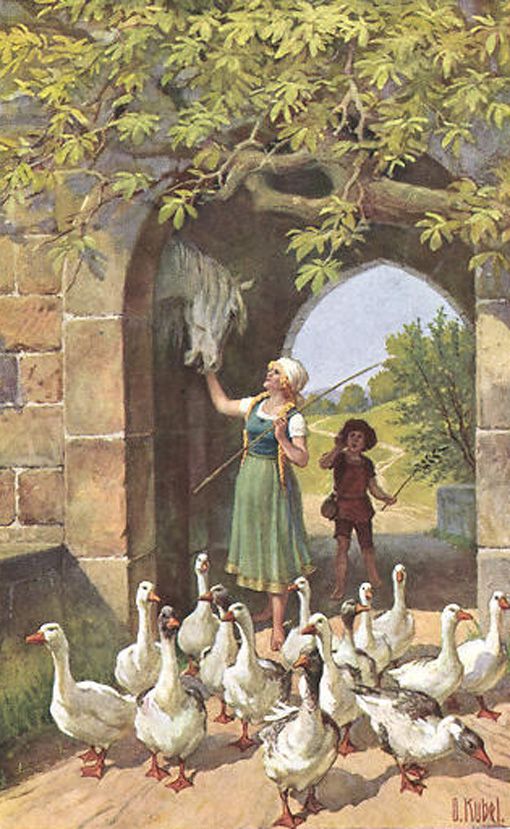 Image: Otto Kubel (1868 – 1951)
Image: Otto Kubel (1868 – 1951)The old King told him to go to drive the geese next morning as usual, and he himself went behind the gate and listened how the maiden spoke to Falada; and then he followed them into the fields, and hid himself behind a bush; and he watched the goose-boy and the goose-girl tend the geese; and after a while he saw the girl make her hair all loose, and how it gleamed and shone. Soon she said:
„O wind, blow Conrad’s hat away,
And make him follow as it flies,
While I with my gold hair will play,
And bind it up
in seemly wise.“
Then there came a gust of wind and away went Conrad’s hat, and he after it, while the maiden combed and bound up her hair; and the old King saw all that went on. At last he went unnoticed away, and when the goose-girl came back in the evening he sent for her, and asked the reason of her doing all this. „That I dare not tell you,“ she answered, „nor can I tell any man of my woe, for when I was in danger of my life I swore an oath not to reveal it.“ And he pressed her sore, and left her no peace, but he could get nothing out of her. At last he said, „If you will not tell it me, tell it to the iron oven,“ and went away. Then she crept into the iron oven, and began to weep and to lament, and at last she opened her heart and said, „Here I sit forsaken of all the world, and I am a King’s daughter, and a wicked waiting-woman forced me to give up my royal garments and my place at the bridegroom’s side, and I am made a goose-girl, and have to do mean service.
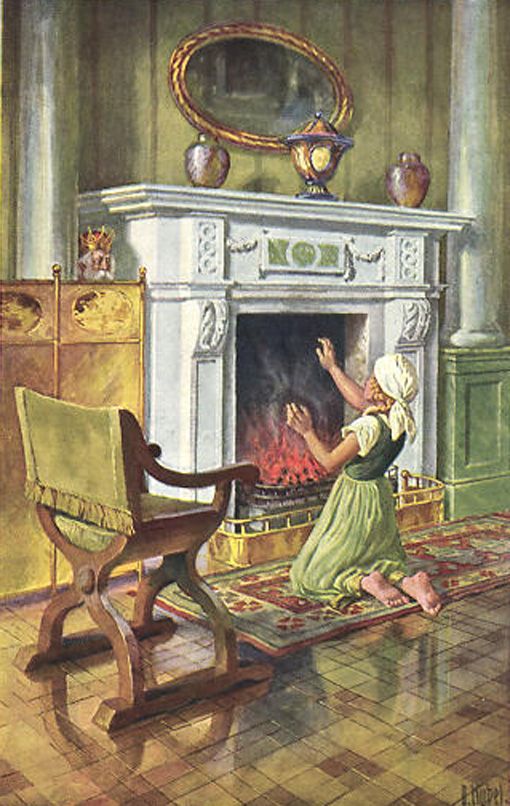 Image: Otto Kubel (1868 – 1951)
Image: Otto Kubel (1868 – 1951)And if my mother knew, it would break her heart.“ Now the old King was standing outside by the oven-door listening, and he heard all she said, and he called to her and told her to come out of the oven. And he caused royal clothing to be put upon her, and it was a marvel to see how beautiful she was. The old King then called his son and proved to him that he had the wrong bride, for she was really only a waiting-woman, and that the true bride was here at hand, she who had been the goose-girl. The Prince was glad at heart when he saw her beauty and gentleness; and a great feast was made ready, and all the court people and good friends were bidden to it. The bridegroom sat in the midst with the Princess on one side and the waiting-woman on the other; and the false bride did not know the true one, because she was dazzled with her glittering braveries. When all the company had eaten and drunk and were merry, the old King gave the waiting-woman a question to answer, as to what such an one deserved, who had deceived her masters in such and such a manner, telling the whole story, and ending by asking, „Now, what doom does such an one deserve?“ – „No better than this,“ answered the false bride, „that she be put naked into a cask, studded inside with sharp nails, and be dragged along in it by two white horses from street to street, until she be dead.“ – „Thou hast spoken thy own doom,“ said the old King, „as thou hast said, so shall it be done.“ And when the sentence was fulfilled, the Prince married the true bride, and ever after they ruled over their kingdom in peace and blessedness.
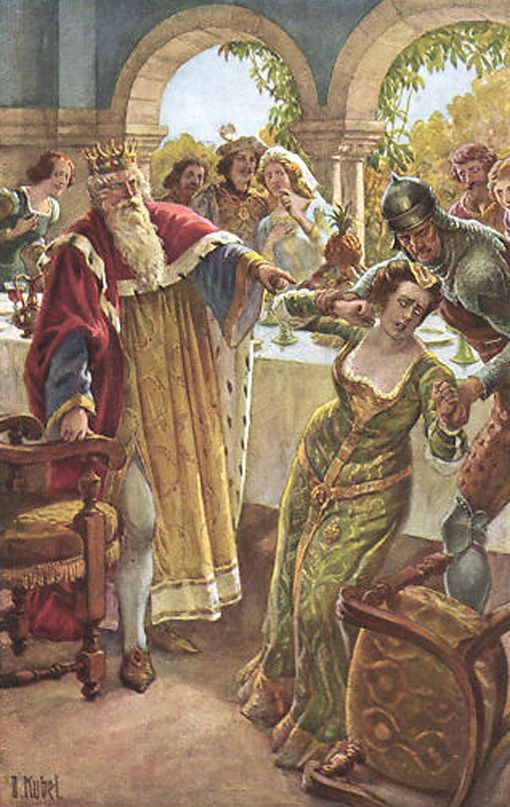 Image: Otto Kubel (1868 – 1951)
Image: Otto Kubel (1868 – 1951) Learn languages. Double-tap on a word.Learn languages in context with Childstories.org and Deepl.com.
Learn languages. Double-tap on a word.Learn languages in context with Childstories.org and Deepl.com.Backgrounds
Interpretations
Adaptions
Summary
Linguistics
„The Goose Girl“ is a German fairy tale that was collected and published by the Brothers Grimm in their book „Grimms‘ Fairy Tales“ (also known as „Children’s and Household Tales“ or „Kinder- und Hausmärchen“ in German) in 1815. The Brothers Grimm, Jacob and Wilhelm Grimm, were German academics and linguists who collected and popularized traditional folktales during the 19th century. Their collection of fairy tales is one of the most well-known and influential works in the genre.
The story of „The Goose Girl“ centers around a young princess who is betrayed by her waiting-woman on their journey to meet the prince the princess is supposed to marry. The waiting-woman forces the princess to switch places with her, and the true princess becomes a goose-girl working in the fields while the false bride marries the prince. With the help of a talking horse named Falada and a wise old King, the true identity of the princess is eventually revealed, and she marries the prince.
The tale is classified as Aarne-Thompson-Uther type 533, which is a classification system for folktales that groups stories with similar plots or themes. Other variations of the story exist in different cultures and regions, although the Grimms‘ version is the most widely known. The story has been adapted into various formats, including films, television shows, and stage productions, and it continues to be a popular and enduring fairy tale.
„The Goose Girl“ by Brothers Grimm can be interpreted in various ways, touching on themes of deception, identity, loyalty, and justice. Here are some interpretations of the fairy tale:
Deception and identity: The story highlights the consequences of deception, as the waiting-woman’s treachery ultimately leads to her downfall. It also explores the theme of hidden identity, as the true princess is forced into a humble position and must endure hardship before her royal identity is revealed.
Loyalty and the power of true nature: The talking horse Falada remains loyal to the true princess, even after death. The princess’s goodness and true nature are eventually recognized, allowing her to regain her rightful place. The story emphasizes the importance of staying true to one’s nature and the power of loyalty.
Justice and retribution: The false bride faces a harsh punishment for her deceit, as she ends up experiencing the brutal fate she suggested for someone who committed similar crimes. This highlights the theme of justice and retribution, demonstrating that deceitful actions have consequences.
The role of fate and destiny: Despite the obstacles the true princess faces, her fate ultimately leads her to regain her rightful place as queen. The story suggests that one’s true destiny cannot be suppressed by the deceptions of others.
Inner strength and resilience: The princess demonstrates remarkable strength and resilience throughout the story, enduring the challenges and maintaining her dignity despite her hardships. This suggests that inner strength and a noble spirit can help overcome adversity.
The importance of compassion and empathy: The old King’s kindness and empathy towards the goose-girl lead him to investigate the situation and ultimately reveal the truth. The story emphasizes the importance of compassion and empathy in understanding the struggles of others and ensuring justice.
„The Goose Girl“ has been adapted in various forms of media over the years, including:
Film adaptations: There have been several film adaptations of „The Goose Girl“, including a silent film from 1909 and a German animated film from 1952. One of the most well-known adaptations is the 2003 Disney film „The Princess Diaries 2: Royal Engagement“, which features a storyline loosely inspired by the fairy tale.
Stage adaptations: „The Goose Girl“ has also been adapted for the stage in various forms, including musicals, plays, and operas. One notable adaptation is the opera „Die Gänsemagd“ by German composer Engelbert Humperdinck, which premiered in 1896.
Literary adaptations: „The Goose Girl“ has been adapted into various forms of literature, including picture books, retellings, and novelizations. One popular retelling is „The Goose Girl“ by Shannon Hale, which was published in 2003 and is part of her „Books of Bayern“ series.
Television adaptations: „The Goose Girl“ has also been adapted for television, including an episode of the animated series „Grimm’s Fairy Tale Classics“ and an episode of the TV show „Faerie Tale Theater“.
Video game adaptations: „The Goose Girl“ has even been adapted into video games, including „King’s Quest VI: Heir Today, Gone Tomorrow“, a classic adventure game from 1992 that features a storyline inspired by the fairy tale.
Overall, „The Goose Girl“ has proven to be a timeless and adaptable story that continues to captivate audiences of all ages and interests.
„The Goose Girl“ is a fairy tale by Brothers Grimm that tells the story of a beautiful princess who is promised in marriage to a king’s son in a distant land. Before her journey, the Queen, her mother, gives her a napkin with three drops of her blood for protection, a waiting-woman to attend her, and a speaking horse named Falada.
During their journey, the waiting-woman becomes cruel and makes the princess drink from a brook without her golden cup, causing her to lose the protective napkin. The waiting-woman then forces the princess to switch places, threatening to kill her if she reveals the truth. They reach the castle, where the false bride is welcomed as the princess, and the real princess is made to tend geese with a boy named Conrad.
The false bride orders Falada to be killed, but the real princess manages to have his head nailed to a gate. Each day, the princess speaks to Falada’s head as she passes, and the head replies. Conrad becomes annoyed with the princess when she magically causes the wind to blow his hat away as he tries to take some of her golden hair.
The old King, suspecting something is amiss, listens to the conversations between the princess and Falada’s head and observes her actions in the field. Unable to get the truth from her directly, he has her speak her woes to an iron oven. Upon hearing her story, the old King reveals her true identity and exposes the false bride.
The false bride is sentenced to a gruesome death, as per her own suggestion for punishment. The prince marries the true princess, and they rule their kingdom in peace and happiness.
The fairy tale „The Goose Girl“ from the Brothers Grimm offers rich material for linguistic analysis, showcasing various elements typical of classical fairy tales.
Introduction: The tale begins with the traditional „once upon a time“ setting, introducing the main characters and the initial predicament.
Plot Development: The narrative moves through a series of events—journey, betrayal, suffering, revelation, and resolution.
Conclusion: It ends with justice being served and a return to rightful order.
Repetition and Parallelism: The story uses repetition for emphasis and to enhance the rhythm, seen in the recurring phrases like the blood drops saying, „If your mother knew of this, it would break her heart. “
– The dialogue between the Princess and Falada’s head is also repeated daily, reinforcing the Princess’s plight and adding a ritualistic, magical quality to the tale.
Direct Speech and Dialogue: The use of direct speech gives immediacy and life to the characters. Each character’s spoken lines reveal their personality and intents, such as the Princess’s kindness, the waiting-woman’s cruelty, and the old King’s wisdom. Dialogue helps drive the narrative forward and provides critical information to the reader in an engaging manner.
Symbolism: Objects like the three drops of blood and the golden hair symbolize purity and royal heritage. Falada, the talking horse, serves as a magical helper element, typical within fairy tales, representing loyalty and truth.
Moral and Didactic Elements: Fairy tales often include moral lessons. „The Goose Girl“ warns against deceit and cruelty, rewarding virtue and rightful conduct. The punishment of the false bride is depicted in a way that emphasizes the inevitability of justice—a common theme in traditional tales meant to instruct readers on moral conduct.
Emotive Language: The fairy tale makes use of emotive language to elicit sympathy for the protagonist, such as terms like “poor Princess,” indicating her undeserved suffering. Descriptions of her golden hair and gentle demeanor enhance her status as a true princess, appealing to the reader’s sense of justice.
Traditional and Cultural Elements: The structure and motifs reflect the narrative tradition of the time, such as the magical elements, royal characters, and rustic settings. The tale upholds societal norms of the period, such as the importance of lineage and rightful rule, further endorsing existing structures through its resolution.
Overall, „The Goose Girl“ is a well-crafted tale utilizing various linguistic tools and traditional fairy tale components to convey its narrative effectively. It maintains a balance between dialogue, description, repetition, and symbolism to create an engaging, morally instructive story.
Information for scientific analysis
Fairy tale statistics | Value |
|---|---|
| Number | KHM 89 |
| Aarne-Thompson-Uther-Index | ATU Typ 533 |
| Translations | DE, EN, DA, ES, PT, FI, HU, IT, JA, NL, PL, RU, TR, VI, ZH |
| Readability Index by Björnsson | 34.7 |
| Flesch-Reading-Ease Index | 78.4 |
| Flesch–Kincaid Grade-Level | 8.6 |
| Gunning Fog Index | 11 |
| Coleman–Liau Index | 7.1 |
| SMOG Index | 8 |
| Automated Readability Index | 9.5 |
| Character Count | 10.949 |
| Letter Count | 8.347 |
| Sentence Count | 85 |
| Word Count | 2.149 |
| Average Words per Sentence | 25,28 |
| Words with more than 6 letters | 203 |
| Percentage of long words | 9.4% |
| Number of Syllables | 2.610 |
| Average Syllables per Word | 1,21 |
| Words with three Syllables | 58 |
| Percentage Words with three Syllables | 2.7% |

 Facebook
Facebook  Whatsapp
Whatsapp  Messenger
Messenger  Telegram
Telegram Reddit
Reddit














